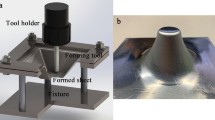Abstract
Research in the last 15 years has led to die-less incremental forming processes that are close to realization in an industrial setup. Whereas many studies have been carried out with the intention of investigating technical abilities and economic consequences, the ecological impact of incremental sheet forming (ISF) has not been studied so far. Using the concept of exergy analysis, two ISF technologies, namely single sided and double sided incremental forming, are investigated and compared to conventional forming and hydroforming. A second exergy analysis is carried out with the purpose of examining the environmental impact of different forming technologies from a supply chain perspective. Therefore, related upstream activities (die set production, aluminum sheet production and energy conversion and supply) are included into the exergy analysis. The entire supply chain is modeled with Matlab/Simulink. The results of both analyses suggest that ISF is environmentally advantageous for prototyping and small production runs.









Similar content being viewed by others
References
Attanasio A, Ceretti E, Giardini C, Mazzoni L (2008) Asymmetric two points incremental forming: improving surface quality and geometric accuracy by tool path optimization. J Mater Process Technol 197:59–67
Heinz A, Haszler A, Keidel C, Moldenhauer S, Benedictus R, Miller WS (2000) Recent development in aluminum alloys for aerospace applications. Mater Sci Eng A280:102–107
Emmens W, Sebastiani G, van den Boogaard A (2010) The technology of incremental sheet forming—a brief review of the history. J Mater Process Technol 210:981–997
Jeswiet J, Micari F, Hirt G, Bramley A, Duflou J, Allwood J (2005) Asymmetric single point incremental forming of sheet metal. CIRP Ann Manuf Technol 54(2):88–114
Cao J, Huang Y, Reddy NV, Malhotra R, Wang Y (2008) Incremental sheet metal forming: advances and challenges. In: International conference on technology of plasticity, Gyeongju, Korea, pp 1967–1982
Park JJ, Kim YH (2003) Fundamental studies on the incremental sheet metal forming technique. J Mater Process Technol 140:447–453
Schuler GmbH (1998) Metal forming handbook. Springer, Berlin. ISBN:3540611851
Allwood JM, King GPF, Duflou J (2005) A structured search for applications of the incremental sheet-forming process by product segmentation. Proc Inst Mech Eng B J Eng Manuf 219(2):239–244
Malhotra R, Cao J, Ren F, Kiridena V, Xia Z.Cedric, Reddy NV (2011) Improvement of geometric accuracy in incremental forming by using a squeezing toolpath with two forming tools. ASME J Manuf Sci Eng (accepted)
Malhotra R, Reddy NV, Cao J (2010) Automatic spiral toolpath generation for single point incremental forming. ASME J Manuf Sci Eng 132(6):061003
Gyftopoulos EP, Beretta BP (2005) Thermodynamics: foundations and applications. Dover Publications, Inc., Mineola, NY. ISBN:0486439321
Bakshi BR, Gutowski TG, Sekulić DP (2011) Thermodynamics and the destruction of resources. Cambridge University Press, New York. ISBN:0521884551
Branham M, Gutowski TG, Jones A, Sekulic DP (2008) A thermodynamic framework for analyzing and improving manufacturing processes. IEEE international symposium on electronics and the environment, 19–20 May 2008
Szargut J, Morris DR, Steward FR (1988) Exergy analysis of thermal, chemical and metallurgical processes. Hemisphere Publishing Corporation, New York. ISBN:0891165746
Lange K (1985) Handbook of metal forming. McGraw-Hill Book Company, New York. ISBN:0070362858
Dahmus JB, Gutowski TG (2004) An environmental analysis of machining. In: Proceedings of IMECE2004, ASME international mechanical engineering congress and RD&D Expo, 13–19 Nov 2004, Anaheim, California USA
Matwick SE (2003) An economic evaluation of sheet hydroforming and low volume stamping and the effects of manufacturing systems analysis. Master of science in engineering thesis, Massachusetts Institute of Technology, Cambridge, MA
Nachtman ES, Kalpakjian S (1985) Lubricants and lubrication in metalworking operations. Marcel Dekker Inc., New York, pp 223–247. ISBN:0824774019
Tschaetsch H (2006) Metal forming practice—processes, machines, tools. Springer, Berlin, pp 158–169. ISBN:3540332162
Ashby MF (2009) Materials and the environment, eco-informed material choice. Butterworth-Heinemann/Elsevier Inc, Amsterdam, Boston. ISBN:1856176088
Smil V (2008) Energy in nature and society—general energetics of complex systems. MIT Press, Cambridge, MA. ISBN:0262693569
Baniszewski B (2005) An environmental impact analysis of grinding. Bachelor of science in mechanical engineering at the Massachusetts Institute of Technology
Buzoverya MT, Yankovskii AS, Budnik LG, Laptev A, Maryasov MF (1985) Analysis of expenditures on heat and energy resources in pig-iron production. Metallurgist 29(12):378–379. doi:10.1007/BF0074290
Capman PF, Leach G, Slesser M (1974) The energy costs of fuels. Energy Policy 2(3):231–243. doi:10.1016/0301-4215(74)90048-2
Green JAS (2007) Aluminum recycling and processing for energy conversion and sustainability. ASM International, Materials Park, Ohio. ISBN:0871708590
Hammond G, Jones C (2011) Inventory of carbon & energy, version 1.6a, University of Bath, UK. Available from: http://www.bath.ac.uk/mech-eng/sert/embodied/. Accessed 23 Jan 2011
Jones A (2007) The industrial ecology of the iron casting industry. Master of science in engineering thesis, Massachusetts Institute of Technology. Cambridge, MA
Koc M (2008) Hydroforming for advanced manufacturing. Woodhead Publishing, Cambridge. ISBN:1420077864
Thiriez A (2006) An environmental analysis of injection molding. Master of science in mechanical engineering at the Massachusetts Institute of Technology
Wall G (1986) Exergy conversion in the Swedish society. Res Energy 9:55–73
Wall G (1990) Exergy conversion in the Japanese society. Energy 15(5):435–444
Worell E, Martin N, Price L (1999) Energy efficiency and carbon dioxide emissions reduction opportunities in the US iron and steel sector. Environmental Energy Technologies Division
Valero A (2010) Exergoecology: a thermodynamic approach for accounting the Earth’s mineral capital. The case of bauxite–aluminum and limestone–lime chains. Energy 35:229–238
Schubert PB (1966) Die methods, design, fabrication, maintenance and application. Industrial Press Inc, Madison, Wisconsin, pp 383–390
Dittrich MA (2011) Exergy analysis of sheet metal prototyping technologies, research report. Leibniz University, Hannover
Kwiatkowski L, Urban M, Sebastiani G, Tekkaya AE (2010) Tooling concepts to speed up incremental sheet forming. Prod Eng Res Dev 4(1):57–64
Acknowledgments
The authors gratefully acknowledge the support of the U.S. Department of Energy, Award DE-EE0003460, technical contact Dr. Debo Archbhaumik.
Author information
Authors and Affiliations
Corresponding author
Rights and permissions
About this article
Cite this article
Dittrich, M.A., Gutowski, T.G., Cao, J. et al. Exergy analysis of incremental sheet forming. Prod. Eng. Res. Devel. 6, 169–177 (2012). https://doi.org/10.1007/s11740-012-0375-9
Received:
Accepted:
Published:
Issue Date:
DOI: https://doi.org/10.1007/s11740-012-0375-9




